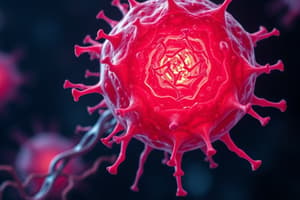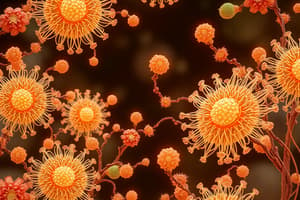Podcast
Questions and Answers
What is the primary purpose of using FACS analysis in the context presented?
What is the primary purpose of using FACS analysis in the context presented?
- To determine cell growth rates
- To analyze nutrient absorption
- To measure enzyme activity
- To assess cell apoptosis (correct)
What does the hypodiploid peak in the cell cycle histogram represent?
What does the hypodiploid peak in the cell cycle histogram represent?
- Normal cell division
- Cellular differentiation
- Senescent cells
- Apoptotic cells (correct)
Why might a general laboratory choose not to use flow cytometry?
Why might a general laboratory choose not to use flow cytometry?
- It requires specialized training only
- It is less sensitive than other methods
- It is difficult to interpret cell cycle data
- It is costly to run and may not be readily accessible (correct)
What factor is indicated by the symbols ** and *** in the context of the drug treatments?
What factor is indicated by the symbols ** and *** in the context of the drug treatments?
Which cell line was used in the FACS analysis along with MDA-MB-231?
Which cell line was used in the FACS analysis along with MDA-MB-231?
What is a noted advantage of flow cytometry over AO/EB staining?
What is a noted advantage of flow cytometry over AO/EB staining?
What is one of the limitations of using flow cytometry as specified?
What is one of the limitations of using flow cytometry as specified?
What does the term experimental replicates refer to in the context given?
What does the term experimental replicates refer to in the context given?
What is the primary purpose of the clonogenic assay?
What is the primary purpose of the clonogenic assay?
Which method is considered more economical compared to flow cytometry?
Which method is considered more economical compared to flow cytometry?
What staining method is used in the colony-forming assay to visualize colonies?
What staining method is used in the colony-forming assay to visualize colonies?
What is the minimum number of cells required for a colony in a clonogenic assay?
What is the minimum number of cells required for a colony in a clonogenic assay?
Which type of cancer cells were used in the clonogenic assay as referenced?
Which type of cancer cells were used in the clonogenic assay as referenced?
Which treatment is known to reduce the development of colorectal cancer as mentioned in the content?
Which treatment is known to reduce the development of colorectal cancer as mentioned in the content?
What condition allows the cells to maintain their morphology during the clonogenic assay?
What condition allows the cells to maintain their morphology during the clonogenic assay?
What is the primary reason for conducting the clonogenic assay after treatment with cytotoxic agents?
What is the primary reason for conducting the clonogenic assay after treatment with cytotoxic agents?
What mutation is correlated with the initiation of more than 80% of colorectal cancers?
What mutation is correlated with the initiation of more than 80% of colorectal cancers?
In the clonogenic assay, what was used to stain the colonies formed by treated HCT-116 cells?
In the clonogenic assay, what was used to stain the colonies formed by treated HCT-116 cells?
Which concentration of phloretin resulted in the most significant reduction of colonies in HCT-116 cells?
Which concentration of phloretin resulted in the most significant reduction of colonies in HCT-116 cells?
What phase of the cell cycle showed accumulation of cells after treatment with phloretin?
What phase of the cell cycle showed accumulation of cells after treatment with phloretin?
What statistical significance was observed in the colony count at 200 µM phloretin compared to control cells?
What statistical significance was observed in the colony count at 200 µM phloretin compared to control cells?
What was the result of the clonogenic assay in terms of colony formation after phloretin treatment?
What was the result of the clonogenic assay in terms of colony formation after phloretin treatment?
Which assay was used to observe apoptosis in cells treated with phloretin?
Which assay was used to observe apoptosis in cells treated with phloretin?
What was used for counting colonies formed in the clonogenic assay?
What was used for counting colonies formed in the clonogenic assay?
Flashcards
Annexin V Apoptosis Assay
Annexin V Apoptosis Assay
A method to detect apoptosis in cells using Annexin V and FACS analysis.
FACS analysis
FACS analysis
Fluorescence-activated cell sorting; a technique to identify and sort cells based on fluorescent markers.
Flow Cytometry
Flow Cytometry
A method to analyze cells based on their fluorescence properties, often used in detecting apoptosis.
Apoptosis
Apoptosis
Signup and view all the flashcards
Cell Cycle Analysis
Cell Cycle Analysis
Signup and view all the flashcards
Hypodiploid Peak
Hypodiploid Peak
Signup and view all the flashcards
Experimental Replicates
Experimental Replicates
Signup and view all the flashcards
Breast Cancer Cells
Breast Cancer Cells
Signup and view all the flashcards
Clonogenic Assay
Clonogenic Assay
Signup and view all the flashcards
Colony Formation
Colony Formation
Signup and view all the flashcards
Cell Survival Assay
Cell Survival Assay
Signup and view all the flashcards
In Vitro
In Vitro
Signup and view all the flashcards
Quantitative Technique
Quantitative Technique
Signup and view all the flashcards
HCT116 Cells
HCT116 Cells
Signup and view all the flashcards
Phloretin
Phloretin
Signup and view all the flashcards
Apoptosis
Apoptosis
Signup and view all the flashcards
APC Mutations
APC Mutations
Signup and view all the flashcards
Clonogenic Assay
Clonogenic Assay
Signup and view all the flashcards
Phloretin Effect
Phloretin Effect
Signup and view all the flashcards
HCT-116 Cells
HCT-116 Cells
Signup and view all the flashcards
Cell Cycle Disruption
Cell Cycle Disruption
Signup and view all the flashcards
Colony Formation Inhibition
Colony Formation Inhibition
Signup and view all the flashcards
Significant Reduction
Significant Reduction
Signup and view all the flashcards
Concentration-Dependent Effect
Concentration-Dependent Effect
Signup and view all the flashcards
Study Notes
Lecture 16 Summary
- Lecture presented by Dr. Kavitha Thirumurugan, Professor HAG, SBST at VIT Vellore Institute of Technology.
- Lecture focused on Fluorescence-activated cell sorting (FACS) analysis of apoptosis in cancer cells.
Annexin V Apoptosis Assay (MCF-7 Cells)
- Annexin V Apoptosis assay using FACS analysis on MCF-7 breast cancer cells.
- Cells treated with different concentrations of SFN, WA, or both compounds.
- Treatment was for 3 days.
- Results show significant apoptosis at higher concentrations (p<0.01, p<0.001)
- Data represents three replicates.
- X-axis displays compound concentration (µM).
Annexin V Apoptosis Assay (MDA-MB-231 Cells)
- Annexin V Apoptosis assay, using FACS on MDA-MB-231 breast cancer cells.
- Cells treated with different concentrations of SFN, WA, or both compounds.
- Treatment was for 3 days.
- Results show significant apoptosis at higher concentrations (p<0.01, p<0.001).
- Data represents three replicates.
- X-axis displays compound concentration (µM).
Flow Cytometry Analysis
- Flow cytometry used by the lecture to analyze the cell cycle in relation to apoptosis.
- Negative control group showed no distinct apoptotic peak.
- Experimental group (undergoing apoptosis) showed an apoptotic peak (Ap peak) before the G1 peak in the histogram.
Flow Cytometry as Method to Detect Apoptosis
- Flow cytometry is a high-sensitivity method for detecting apoptosis.
- It can be used to study the cell cycle simultaneously.
- General laboratories may not have the required equipment (flow cytometer).
- Cost associated with the equipment might be a factor.
- AO/EB staining may be a viable alternative.
Clonogenic Assay
- Clonogenic or Colony Forming Assay is an in vitro technique used to quantify cells capacity to grow into a colony.
- Defined by colonies of at least 50 cells.
- Assesses every cell's ability to undergo uncontrolled division.
Clonogenic Assay as method to determine Cell Reproductive Death
- Clonogenic assay is a critical method for determining cell reproductive death following treatment with ionizing radiation, or other cytotoxins.
- Only a fraction of seeded cells can form colonies.
- Colonies are developed in 1-3 weeks.
- Colonies fixed using glutaraldehyde and stained using crystal violet, then counted with a stereomicroscope.
HCT116 Colony Forming Assay Protocol
- Protocol for assessing the effects of drug treatment on HCT116 colorectal cancer cells.
- Seeding density of 10000 cells per well.
- Cells allowed to reach 30-40% confluency (before treatment)
- Treatment with specific drug concentrations in media.
- Incubation for 3 days (at 37°C, 5% CO2).
- Fixation and staining with Coomassie Blue stain after treatment.
Clonogenic Assay of HCT116 Cells (Treatment with Phloretin)
- HCT116 colorectal cancer cells are treated with phloretin (at various concentrations).
- Phloretin, a dihydrochalcone polyphenol, is found in apples, pears, strawberries.
- Phloretin inhibits CRC development by acting on glucose transporters, and activating p53.
- Over 80% of CRC are initiated by APC (adenomatous polyposis coli) mutations linked with Wnt activation.
Clonogenic assay of HCT116 cells: Image Analysis with Phloretin
- Image analysis was used to quantify the growth of HCT-116 cells after treatment with various concentrations of phloretin.
- The analysis revealed a reduction in the number of colonies as concentrations increased.
- Significant reduction in colony formation at higher concentrations (p<0.05, to p<0.0001).
Clonogenic Assay: Treatment Results and Colony Reduction with Phloretin
- Treatment with phloretin significantly reduced the number of colonies formed in HCT-116 cells (compared to control).
- This reduction was significant (p<0.0001) at the highest concentration of phloretin used.
- Demonstrates Inhibitory effect of phloretin on CRC proliferation
Flow Cytometry Results (HCT-116): Treatment with Phloretin Analysis
- Flow cytometry was employed to investigate the mechanism by which phloretin inhibits cell proliferation in HCT-116 cells.
- There was altered pattern in cell cycle distribution following treatment (increased G2/M phase accumulation).
- Accumulation in G2/M phase showed significant increase (p<0.0001)
Apoptosis Results (HCT-116): Phloretin treatment Analysis
- Assessing the percentage of early- and late-apoptotic cells in HCT-116 cells after phloretin treatment.
- Early and late apoptotic cells significantly increased with higher phloretin concentrations.
- This increase suggests phloretin treatment induces apoptosis in a concentration dependent manner.
Summary of Phloretin's Effect
- Phloretin significantly inhibits HCT-116 cell proliferation.
- Phloretin induces apoptosis in HCT-116 cells in a concentration dependent manner.
Additional experiments
- Further analysis was performed in HCT-116 and SW-480 cells to investigate phloretin-induced apoptosis, showing the significant increase of early and late apoptosis at higher concentrations.
Studying That Suits You
Use AI to generate personalized quizzes and flashcards to suit your learning preferences.
Description
This quiz delves into the fluorescence-activated cell sorting (FACS) analysis of apoptosis in MCF-7 and MDA-MB-231 breast cancer cells. You will explore the effects of different concentrations of SFN and WA compounds on apoptosis rates over a three-day treatment period. Test your knowledge on the methodology and findings of the Annexin V Apoptosis assay.




